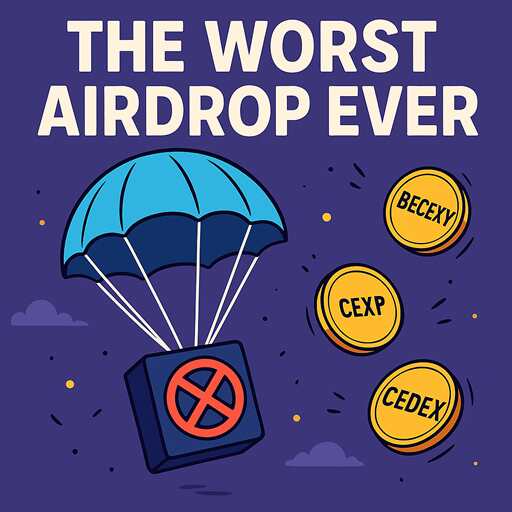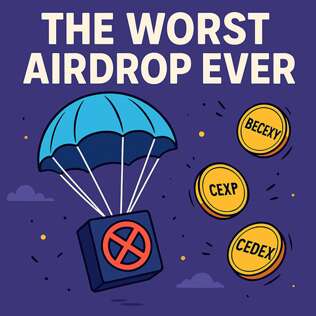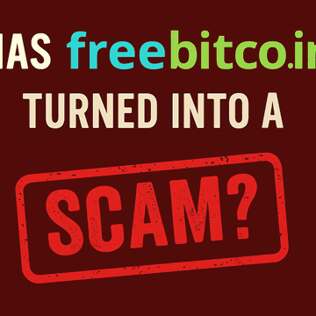The Worst Airdrop Ever: CEXP, BECEXY from CEX․IO & CEDEX
The centralized exchange CEX.IO, now ranked ~80 in the world, back in May 2024 announced an airdrop of what would be their own token, CEXP; similar to what BNB is to Binance, minus the smart blockchain. They scheduled the airdrop to take place in Q4 of 2024. It got a lot of traction, with over 10 million concurrent users in their Telegram tap Airdrop app, within a month, and over 40 million total.
What began as a clickable, gamified promise of a native exchange token, CEXP, turned into a stretch of games, delays, side projects, broken promises, and a rebrand pivot toward something called BeCEXY, a solana meme coin, with no direct or clear relation to CEX.IO. The result: millions of hours of human time farmed, confusing mechanics, and a pre-qualification queue that feels more like a bureaucratic obstacle course than a rewards program.
CEX.IO: “The team behind Power Tap is moving it to BeCEXY, which isn’t connected to CEX.IO. Any future communication or questions about Power Tap should be directed to BeCEXY.
From this moment, Power Tap is not owned, managed, or connected to CEX.IO in any way. CEX.IO’s exchange operations remain the same.”

What happened:
May-Q3 2024
CEX.IO launches the Power Tap game and posts a roadmap that mentions an eventual native token, CEXP, plus integration with CEDEX and other mini games. The roadmap and the Power Tap concept are official.
Then the first black mark arrived, of many to come. They announced season 2, a new game that created super inflation of their token, completely diluting the share of tokens one could have achieved playing for months the tap game. Within a few hours of playing the new cards/evolution game, you could get mare tokens.
Q4 2024
The airdrop was postponed to 2025; to get the most tokens, you had to play 2 more apps, Wigwam and CEDEX.
Early-mid 2025
They then created a stealthy, unannounced Season 3, where they added a roulette wheel, which again created token inflation, devaluing previous game hours.
The CEXP roadmap was deleted; in fact, they canceled the CEXP token (and CEDEX token), removed it from the Cex.io official app, and created a new token, BeCexy, which is like a meme coin of a Bee on solana, with no announced clear use and relation to the exchange. They never released any whitepaper, tokenomics, and we have no idea of the total max supply.
Also, TGE (Token Generation Event) was announced to have already started on two occasions, officially, which was a straight lie.
Q4 2025-2026
While the CEDEX and old CEXP apps continue to work, and make money for the CEX company, with user actions, these users will get nothing if they don’t do one “final” step, getting a special code to enter a new verification list on Becexy, limited to 1 million users, which is advancing at an extra slow pace, like 3% each week, it may not be finished by the end of 2025.
The problem is users inside the verification list are still "Pending verification" and the Becexy team has already hinted at a new future step, which will probably be the finally final last verification, possibly. That would make it season/step 5 or 6, who is counting at this point.
The core problem.
At first glance, this looked like a classic exchange native token rollout: a clicker game to onboard users, snapshots to record activity, then an airdrop and listing. That is a fair model, in theory. In practice, the organizers repeatedly modified the rules and the reward curves in ways that devalued earlier players’ efforts.
How that happened, practically:
- New mini games and “boosts” let latecomers multiply their allocation far more cheaply than early players could earn it. In other words, token inflation was engineered via gameplay mechanics rather than transparent tokenomics. CEDEX and the farming boosts explicitly advertise multipliers and invites that multiply gains.
- The roadmap timeline moved forward and then forward again; snapshots and “season” mechanics were added retroactively. Everybody who spent hours in Season 1 suddenly had their share diluted by Season 2, and the roulette style Season. Community trackers now show repeated postponements of the listing/TGE.
- Then came the pivot: social channels and the new BeCEXY portal became the “final” gate for qualification, and users were asked to verify emails, connect wallets, enter codes, and in many cases, recruit referrals to increase their position. Some of this is documented on the official portal and the exchange’s social accounts.
Transparency? Not exactly
Airdrops and token launches survive or fail on two things: clear tokenomics and predictable mechanics. What we saw instead was a steady scatter of game mechanics, marketing pushes, and gated stages. Official pages still list the roadmap and the portal, but there is a notable absence of publicly consumable, detailed tokenomics that explain max supply, allocation buckets, vesting, and concrete distribution math for CEXP or BeCEXY. Third party token explorers do show an on chain CEXP contract and supply data for some deployed tokens, which complicates claims like “there’s no supply info at all.” Still, the official narrative on distribution and the community facing mechanics did not add up for many users.
Influence marketing and amplification: cheap promotion, expensive consequences
If you’ve been swamped with long form promotional videos, hype posts, and “how to get the secret code” tutorials, there’s a reason. The project triggered a global push of small influencers in many emerging markets creating reams of often incorrect or misleading content. Those creators help the ecosystem grow numbers, while many of the videos prioritize views and referral codes over accuracy. You can find countless influencer walkthroughs and “get the code” tips across YouTube and social feeds. The net effect: enormous user growth, lots of attention, and a lot of time sunk by participants.
Is it a scam? Legal lines and the human cost
I’m going to be blunt, because the shape of this mess matters more than the word “scam.” Legally, a scam requires intent to defraud and typically some clear misrepresentation of facts for personal gain, in a way could meet jurisdictional fraud standards. This could be the worst airdrop in history that might not legally qualify as a scam, and they could get away with it.
What it is, unambiguously:
- A system that monetizes time and attention, not only data or money. People invested hours and invites to earn an expected allocation. That time is gone whether the airdrop happens, or if the reward is diluted to near zero.
- A highly opaque reward model with frequent retroactive changes that benefit later, cheaper ways to farm allocation (boost purchases, invites, roulette spins).
- An attention funnel supported by paid influencer content that often confuses more than it clarifies.
So yes, this feels morally shady, and some people are calling it the biggest airdrop scam based on outcome: massive time wasted, unclear or vanishing payoff. But from a purely legal standpoint, courts and regulators will look for documented misrepresentation or illegally obtained funds. That’s a higher bar. Always consider both the ethical and legal dimensions.
Final take: they farmed time, not tokens
This whole project looks like a masterclass in attention harvesting. The users provided the engagement; the ecosystem sold promotion and uncertainty back to them in the form of extra games, a new portal, codes, and invitations. Whether you call it a scam or poor product design, the end result is similar: lots of human hours exchanged for a promise.
If you had to trade a piece of your future to get a handful of potential tokens today, the price would be the time you can never recover.
If you received 10 million dollars but could never wake up tomorrow, would you take it? That’s how valuable time is.


